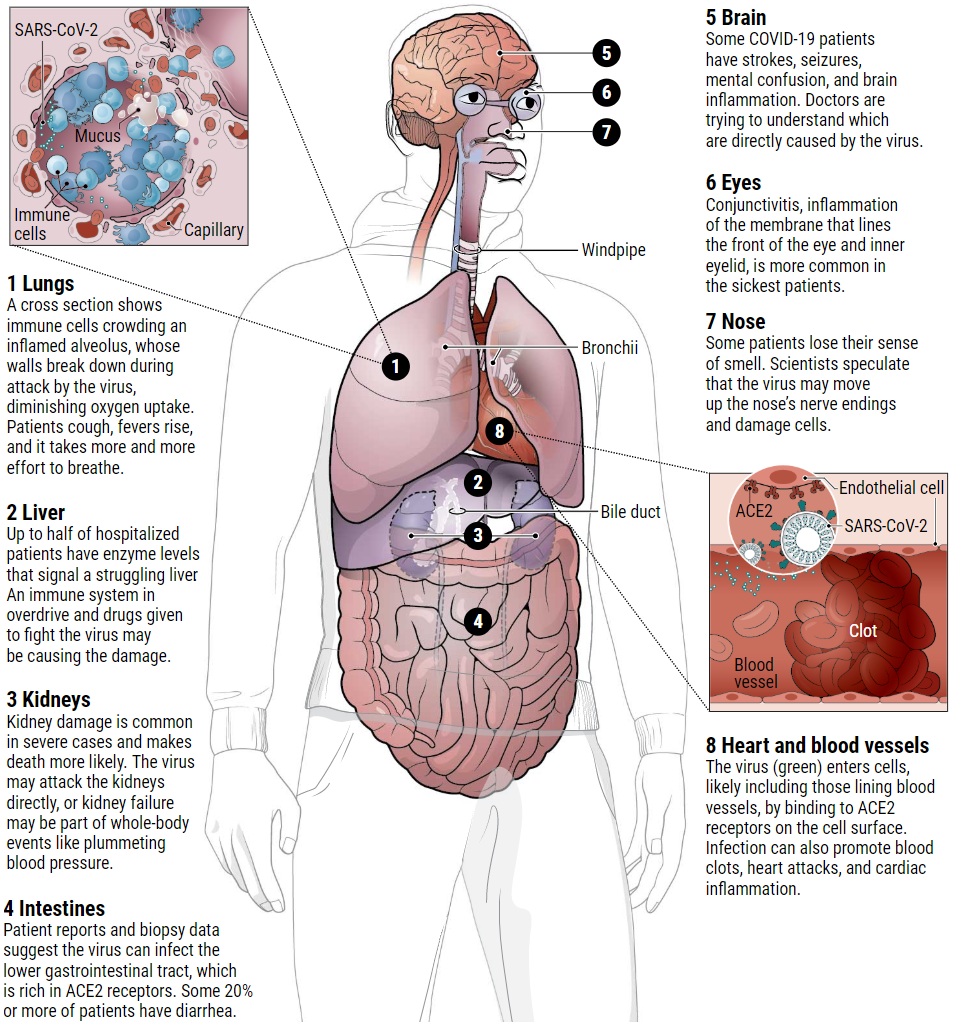每日外闻74
How does coronavirus kill? Clinicians trace a ferocious rampage through the body, from brain to toes
How does coronavirus kill? -1
冠状病毒是如何杀死人的?临床医生们追踪了病毒在整个身体的扩散和侵袭。

计算机断层扫描的3D模型显示,冠状病毒对一名死于乔治华盛顿大学医院的59岁男子的肺部造成了大面积损害(黄色)。
杜兰大学医学院的肺科和重症监护(critical care)医生乔舒亚·丹森(Joshua Denson)最近在一个有20个床位的重症监护病房(ICU)查房时,对两名癫痫患者进行了检测评估,其中许多人患有呼吸衰竭,还有一些人的肾脏正处于危险的衰竭状态。几天前,他的团队试图救活一名心脏停止跳动的年轻女子,但失败了。丹森(Denson)说,他们都有一个共同点。“他们都感染了新型冠状病毒。”
随着全球确诊的covid19病例数量激增-超过220万确诊,死亡人数超过15万,临床医生和病理学家正在努力了解冠状病毒对人体造成的损害。他们意识到,虽然肺部是病毒的感染的起点,但它可以扩散到许多器官,包括心脏和血管、肾脏、肠道和大脑。
耶鲁大学和耶鲁-纽黑文医院的心脏病学家Harlan Krumholz说:“这种病毒几乎可以攻击人体内的任何东西,并带来毁灭性的后果。它的凶猛程度令人惊叹。”
理解病毒如何侵袭的人体可以帮助一线医生治疗那些陷入绝望、有时神秘生病的感染者。新近观察到的危险的凝血倾向是否会将一些轻微的病例转变为危及生命的紧急状况?在最严重的病例背后,是否存在一种过度的免疫反应,从而使用免疫抑制药物可能有所帮助?如何解释一些医生报告的患者血氧水平低得惊人,但他们却没有呼吸困难?宾夕法尼亚大学医院的肺部疾病专家Nilam Mangalmurti说:当我们开始考虑治疗方案时,采用系统的方法可能是有益的。
以下是关于病毒如何攻击人体细胞的快速发展的认识,特别是在大约5%的危重病人身上。尽管现在每周都有超过1000篇论文在期刊投稿,1000篇论文在等待发表,但由于病毒的表现就像人类从未见过的微生物一样,所以很难有一个清晰的认识的画面。如果没有更大规模的前瞻性对照研究,科学家们就必须从小型研究和案例报告中获取信息,这些研究和案例报告以惊人的速度发表,而且往往没有同行的评审修订。“随着这种现象的发展,我们需要保持一种非常开放的心态,我们仍在学习。”目前正在治疗19例covid19患者的拉什大学医学中心(Rush University Medical Center)肝脏移植医生南希·罗(Nancy Reau)说。
How does coronavirus kill? Clinicians trace a ferocious rampage through the body, from brain to toes
On rounds in a 20-bed intensive care unit (ICU) one recent day, physician Joshua Denson assessed two patients with seizures, many with respiratory failure and others whose kidneys were on a dangerous downhill slide. Days earlier, his rounds had been interrupted as his team tried, and failed, to resuscitate a young woman whose heart had stopped. All shared one thing, says Denson, a pulmonary and critical care physician at the Tulane University School of Medicine. “They are all COVID positive.”
As the number of confirmed cases of COVID-19 surges past 2.2 million globally and deaths surpass 150,000, clinicians and pathologists are struggling to understand the damage wrought by the coronavirus as it tears through the body. They are realizing that although the lungs are ground zero, its reach can extend to many organs including the heart and blood vessels, kidneys, gut, and brain.
“[The disease] can attack almost anything in the body with devastating consequences,” says cardiologist Harlan Krumholz of Yale University and Yale-New Haven Hospital, who is leading multiple efforts to gather clinical data on COVID-19. “Its ferocity is breathtaking and humbling.”
Understanding the rampage could help the doctors on the front lines treat the fraction of infected people who become desperately and sometimes mysteriously ill. Does a dangerous, newly observed tendency to blood clotting transform some mild cases into life-threatening emergencies? Is an overzealous immune response behind the worst cases, suggesting treatment with immune-suppressing drugs could help? What explains the startlingly low blood oxygen that some physicians are reporting in patients who nonetheless are not gasping for breath? “Taking a systems approach may be beneficial as we start thinking about therapies,” says Nilam Mangalmurti, a pulmonary intensivist at the Hospital of the University of Pennsylvania (HUP).
What follows is a snapshot of the fast-evolving understanding of how the virus attacks cells around the body, especially in the roughly 5% of patients who become critically ill. Despite the more than 1000 papers now spilling into journals and onto preprint servers every week, a clear picture is elusive, as the virus acts like no microbe humanity has ever seen. Without larger, prospective controlled studies that are only now being launched, scientists must pull information from small studies and case reports, often published at warp speed and not yet peer reviewed. “We need to keep a very open mind as this phenomenon goes forward,” says Nancy Reau, a liver transplant physician who has been treating COVID-19 patients at Rush University Medical Center. “We are still learning.”
See you tomorrow


